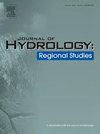黄河流域灌溉和造林加剧了地下水枯竭:基于GRACE和井监测数据的时空分析及其可持续管理意义
IF 4.7
2区 地球科学
Q1 WATER RESOURCES
引用次数: 0
摘要
研究区域:黄河流域。利用GRACE卫星数据和地下水位实测资料,分析了黄河流域地下水库容变化趋势及其影响因素。建立了土壤-水平衡模型来模拟地下水补给(GWR),量化了流域尺度上地下水补给与GWR之间的差异。GWS和GWR的时空变化是识别枯竭风险区域和评价地下水可持续性的重要指标。结果表明:2002 - 2022年,长江三角洲陆地储水量减少52.28 Gt, GWS减少77.02 Gt,除源区GWS显著增加外,全流域GWS以5.56 Gt/年的速率减少。YRB的年GWR为103 mm/年,呈8.5 mm/ 10年的稳定增长。然而,在长江中下游,GWR未能补偿消费。大约73.71% %的长江三角洲地区被确定为地下水危险区。在源区,降水和融雪等自然因子是地下水变化的主要驱动力。中游以造林和灌溉为主,下游以农业为主。本文章由计算机程序翻译,如有差异,请以英文原文为准。
Groundwater depletion intensified by irrigation and afforestation in the Yellow River Basin: A spatiotemporal analysis using GRACE and well monitoring data with implications for sustainable management
Study region
Yellow River Basin.
Study focus
This study analyzes trends in groundwater storage (GWS) changes and their influencing factors in the Yellow River Basin (YRB) using GRACE satellite data and groundwater level measurements. The Soil-Water-Balance model was developed to simulate groundwater recharge (GWR), quantifying the discrepancies between GWS and GWR at the basin scale. Spatiotemporal changes in GWS and GWR are critical indicators for identifying regions at risk of depletion and evaluating groundwater sustainability.
New hydrological insights for the region
The results indicate that between 2002 and 2022, the YRB experienced a reduction of 52.28 Gt in terrestrial water storage, with the GWS losing 77.02 Gt. Except for the significant increase in GWS in the source region, GWS decreased at a rate of 5.56 Gt/yr for entire basin. The annual GWR in the YRB was 103 mm/yr, showing a steady increase of 8.5 mm/decade. However, in the middle and lower reaches of the YRB, GWR failed to compensate for consumption. Approximately 73.71 % of the YRB area was identified as a groundwater risk zone. In the source region, natural factors such as precipitation and snowmelt are the primary drivers of groundwater changes. In contrast, afforestation and irrigation play key roles in the middle reaches, while agricultural is the dominant factor in the lower reaches.
求助全文
通过发布文献求助,成功后即可免费获取论文全文。
去求助
来源期刊

Journal of Hydrology-Regional Studies
Earth and Planetary Sciences-Earth and Planetary Sciences (miscellaneous)
CiteScore
6.70
自引率
8.50%
发文量
284
审稿时长
60 days
期刊介绍:
Journal of Hydrology: Regional Studies publishes original research papers enhancing the science of hydrology and aiming at region-specific problems, past and future conditions, analysis, review and solutions. The journal particularly welcomes research papers that deliver new insights into region-specific hydrological processes and responses to changing conditions, as well as contributions that incorporate interdisciplinarity and translational science.
 求助内容:
求助内容: 应助结果提醒方式:
应助结果提醒方式:


